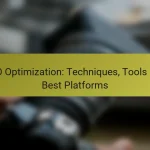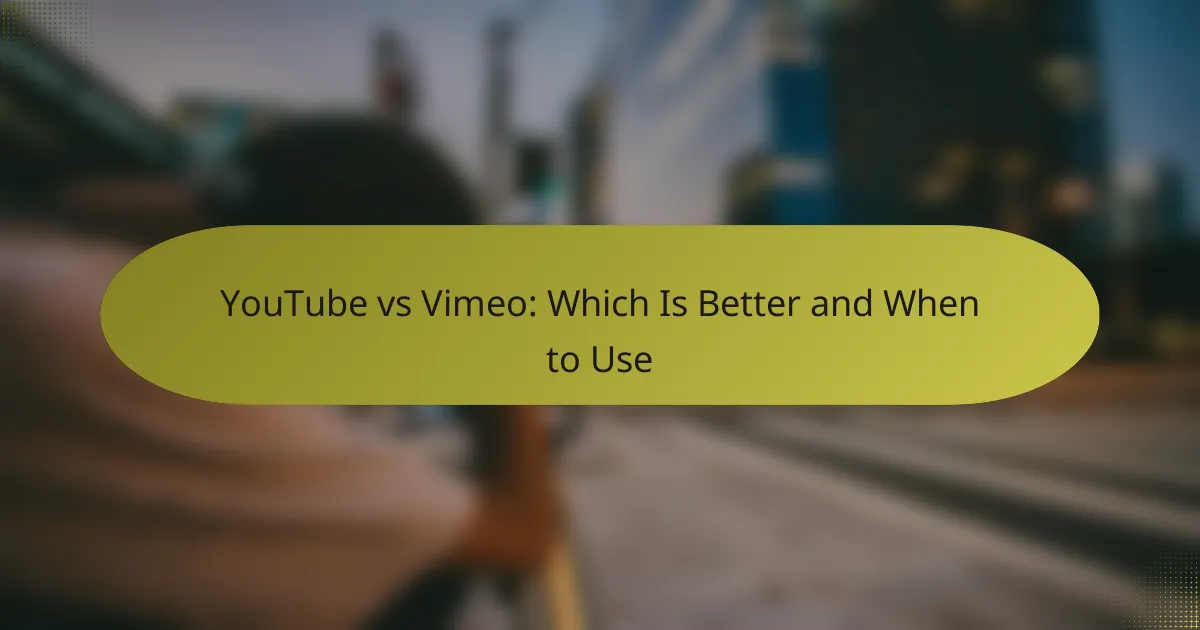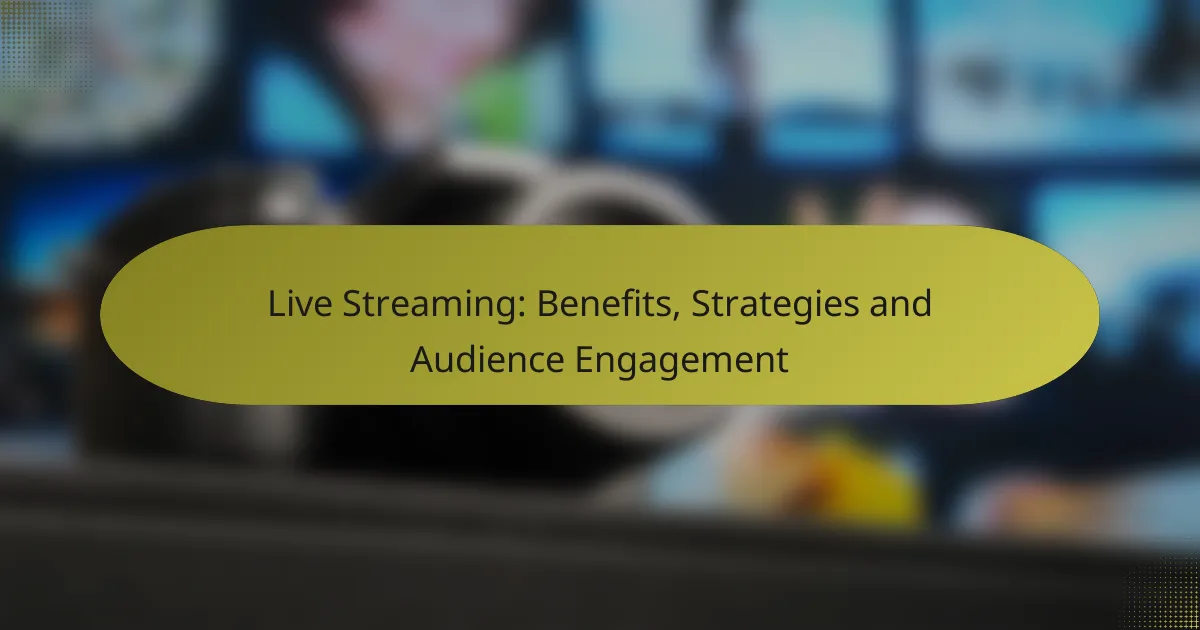Social media has become an essential tool for businesses seeking to enhance their online presence and engage with their audience. By leveraging various platforms tailored to specific demographics, companies can implement targeted strategies that drive lead generation and foster meaningful interactions. A well-defined social media strategy not only aligns with business goals but also cultivates a vibrant community through active engagement and feedback.

Which social media platforms are most effective for lead generation?
Effective lead generation can be achieved through various social media platforms, each offering unique advantages. The choice of platform often depends on the target audience and the nature of the business.
Facebook for targeted advertising
Facebook is a powerful tool for targeted advertising due to its extensive user data and advanced targeting options. Businesses can create ads that reach specific demographics, interests, and behaviors, making it easier to connect with potential leads.
Utilizing Facebook’s ad manager, companies can set budgets and schedule ads to optimize their reach. Consider using A/B testing to refine your ads based on performance metrics.
LinkedIn for B2B engagement
LinkedIn is the premier platform for B2B engagement, allowing businesses to connect with professionals and decision-makers. Its focus on professional networking makes it ideal for lead generation in industries like technology, finance, and consulting.
To maximize effectiveness, share valuable content, participate in relevant groups, and utilize LinkedIn’s InMail feature to directly reach potential leads. Regularly updating your company page can also enhance visibility.
Instagram for visual storytelling
Instagram excels in visual storytelling, making it a great platform for brands that can showcase their products or services through engaging images and videos. This platform appeals particularly to younger demographics and lifestyle brands.
Utilize features like Stories and Reels to create dynamic content that captures attention. Incorporating user-generated content can also enhance authenticity and encourage engagement.
Twitter for real-time interaction
Twitter is effective for real-time interaction and engagement, allowing businesses to connect with their audience instantly. Its fast-paced environment is ideal for sharing updates, promotions, and responding to customer inquiries.
Use hashtags strategically to increase visibility and participate in trending conversations. Regularly engaging with followers can help build relationships and foster loyalty.
Pinterest for niche markets
Pinterest is particularly effective for reaching niche markets, especially in areas like fashion, home decor, and DIY projects. Users often visit Pinterest with the intent to discover and plan, making it a valuable platform for lead generation.
Create visually appealing pins that link back to your website or product pages. Consider using rich pins to provide additional information and enhance user engagement.

How to develop a successful social media strategy?
To develop a successful social media strategy, identify your target audience and set clear goals that align with your business objectives. This approach ensures that your efforts are focused and measurable, leading to better engagement and results.
Define target audience and goals
Defining your target audience involves understanding their demographics, interests, and online behaviors. Create detailed buyer personas to visualize who you are trying to reach, which helps tailor your content effectively.
Set specific, measurable, achievable, relevant, and time-bound (SMART) goals for your social media efforts. For example, aim to increase your followers by a certain percentage within a few months or boost engagement rates by a specific amount.
Choose appropriate platforms
Selecting the right social media platforms is crucial for reaching your audience effectively. Consider where your target demographic spends their time; for instance, younger audiences may prefer TikTok or Instagram, while professionals might be more active on LinkedIn.
Each platform has unique features and user expectations. Tailor your content style and messaging to fit the platform’s culture, whether it’s visual storytelling on Instagram or professional insights on LinkedIn.
Create a content calendar
A content calendar helps you plan and organize your posts in advance, ensuring a consistent presence across your chosen platforms. Schedule content around key dates, events, or campaigns relevant to your audience.
Include a mix of content types in your calendar, such as promotional posts, educational articles, and engaging visuals. This variety keeps your audience interested and encourages interaction.
Utilize analytics for optimization
Regularly review analytics to assess the performance of your social media strategy. Key metrics include engagement rates, reach, and conversion rates, which provide insights into what works and what needs adjustment.
Use these insights to refine your content and posting strategies. For instance, if a particular type of post generates high engagement, consider increasing its frequency or creating similar content to capitalize on that interest.

What are the best practices for social media engagement?
Effective social media engagement involves strategies that foster interaction and build community. Key practices include responding to comments promptly, encouraging user-generated content, hosting interactive sessions, and utilizing polls and surveys to gather feedback.
Respond promptly to comments
Timely responses to comments can significantly enhance engagement on social media. Aim to reply within a few hours to show followers that their input is valued. This can lead to increased loyalty and a stronger community feeling.
Consider setting aside specific times each day to monitor and respond to comments. Use tools that notify you of new interactions to ensure no comment goes unnoticed.
Encourage user-generated content
User-generated content (UGC) can enrich your brand’s social media presence. Encourage followers to share their experiences with your products or services by creating specific hashtags or running contests. This not only boosts engagement but also provides authentic content for your brand.
Highlighting UGC on your official pages can motivate more users to participate. For example, feature a “Fan of the Month” post that showcases the best user submissions.
Host interactive sessions like Q&As
Hosting Q&A sessions can create a direct line of communication between your brand and followers. Schedule regular live sessions where users can ask questions and receive immediate answers, fostering a sense of community and transparency.
Promote these sessions in advance to maximize participation. Consider using platforms like Instagram Live or Facebook Live, where followers can engage in real-time.
Utilize polls and surveys
Polls and surveys are effective tools for engaging your audience and gathering insights. Use them to ask followers about their preferences, opinions, or feedback on products. This not only engages users but also provides valuable data for your marketing strategies.
Keep polls simple and quick to answer, ideally with a few options. You can use features available on platforms like Twitter and Instagram Stories to make participation easy and fun.

What metrics should be tracked for social media success?
To measure social media success, focus on key metrics that reflect engagement, conversion, and growth. These metrics provide insights into how well your content resonates with your audience and its effectiveness in driving business goals.
Engagement rate
Engagement rate measures the level of interaction your content receives from your audience, including likes, shares, comments, and reactions. A higher engagement rate indicates that your audience finds your content relevant and compelling.
To calculate engagement rate, divide the total engagement actions by the total followers or reach, then multiply by 100 to get a percentage. Aim for an engagement rate of around 1% to 5%, depending on your industry and platform.
Conversion rate
Conversion rate tracks the percentage of users who take a desired action after interacting with your social media content, such as signing up for a newsletter or making a purchase. This metric is crucial for evaluating the effectiveness of your campaigns.
To calculate conversion rate, divide the number of conversions by the total interactions and multiply by 100. A typical conversion rate for social media can range from 1% to 3%, but this varies by sector and campaign type.
Follower growth
Follower growth indicates how quickly your audience is expanding on social media platforms. A steady increase in followers suggests that your content is attracting interest and that your brand is gaining visibility.
Monitor follower growth by tracking the number of new followers over specific periods, such as weekly or monthly. Aim for a consistent growth rate, ideally between 2% to 5% per month, to ensure your audience is engaged and expanding.
Traffic to website
Traffic to your website from social media measures how many visitors are directed to your site through social media channels. This metric helps assess the effectiveness of your social media strategy in driving potential customers to your online presence.
Use tools like Google Analytics to track the number of visitors coming from social media platforms. A good benchmark is to aim for at least 10% of your total website traffic to come from social media sources, depending on your overall marketing strategy.

How to choose the right social media tools?
Choosing the right social media tools involves assessing your specific needs and objectives. Focus on features that enhance your engagement and streamline your processes while considering how well these tools integrate with your existing systems.
Evaluate based on features
When evaluating social media tools, prioritize features that align with your marketing goals. Look for capabilities such as scheduling posts, analytics tracking, audience targeting, and content creation tools. For example, if you aim to boost engagement, tools with robust analytics can help you understand what content resonates with your audience.
Consider the user interface and ease of use as well. A tool that is intuitive can save time and reduce the learning curve for your team. Read reviews and conduct trials to see which features are most beneficial for your specific use case.
Consider integration capabilities
Integration capabilities are crucial when selecting social media tools, as they determine how well the tool works with your existing software. Tools that seamlessly integrate with CRM systems, email marketing platforms, or analytics software can enhance your overall marketing strategy. For instance, a social media tool that connects with your email platform can help you leverage customer data for targeted campaigns.
Check for compatibility with popular platforms like Salesforce, HubSpot, or Google Analytics. This ensures that you can easily share data across systems, which can lead to more informed decision-making and improved efficiency. Avoid tools that require extensive manual data entry or lack integration options, as these can hinder your workflow.










